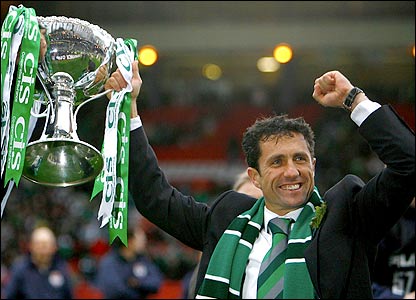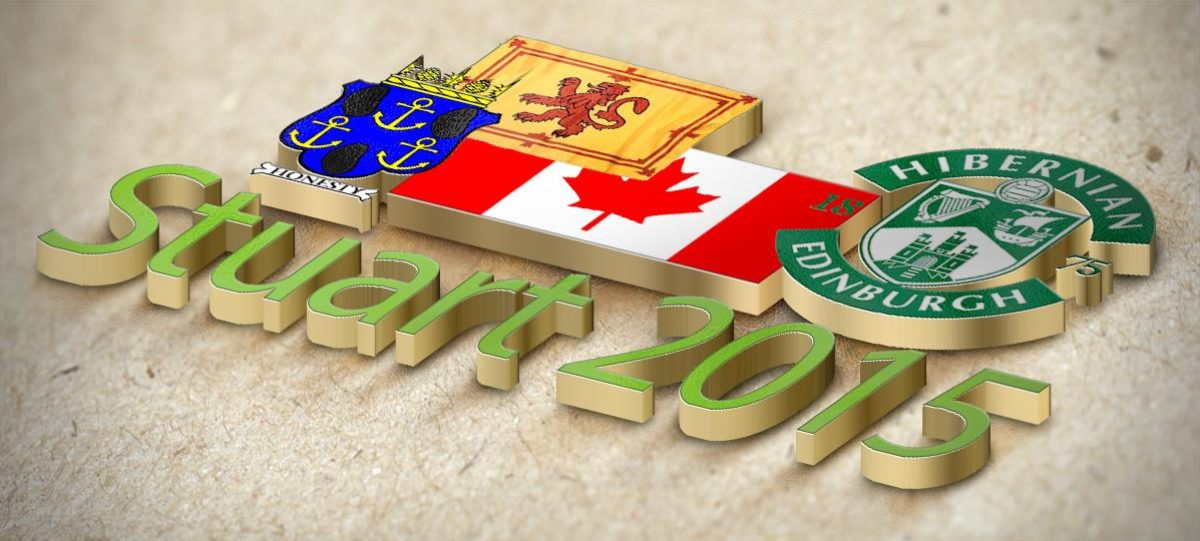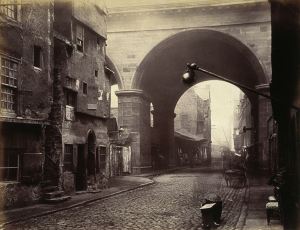Welcome to a short history of Hibernian Football Club, the Green and White side of the Edinburgh professional football scene. ‘The Hibees’ play at Easter Road Stadium in Leith and have a proud, honourable and intriguing history stretching all the way back to 1875!
Hibernian Football Club has been part of the fabric and culture of Scotland’s capital since it’s early inception. The club’s name is most usually abbreviated to ‘Hibs’ by fans and media alike. The club sports an impressive 17,500 seat facility in Easter Road Stadium where they play their home games.
Hibs have traditionally played in green and white strips since their formation, a pointer back to the Irish origins of the club. These origins emanate and embrace Irish emigration into Scotland and its capital during the dark days of the Irish potato famine when many were displaced into the country and further afield around the world. The club badge has had several incarnations and it’s most recent one refers inclusively back to history and to the geographical placing of the organisation in its emblem of the Irish Harp, the castle depicting Edinburgh’s garrison and the ship signifying the port of Leith, respectively.
The club enjoys something of a high-profile fan base amongst its regular faithful fans. Notably, author Irvine Welsh has featured the club in his novels on many a memorable occasion, even hitting celluloid in the case of Trainspotting. Singing duo The Proclaimers contributed a modern-day and much-loved theme to the Easter Road terraces in their emotional ballad Sunshine on Leith. Further regular literary mentions also abound in Ian Rankin’s Inspector Rebus stories in which his assistant is depicted as a ‘Hibby’.

Charlie and Craig Reid -The Proclaimers
So who are this team then? What is the lifeblood that has characterised this green and white phenomenon since its inception? Let’s take a leisurely and enjoyable stroll the through the history book to find out a little more about its rich past.
The club was originally formed, largely by the efforts of Canon Hannan, an Irish priest originally hailing from County Roscommon, in the environs of St. Patrick’s Church in the heart of Edinburgh’s ‘Little Ireland’ of the day. The church still remains in the historic Cowgate area, now a world heritage site. The club’s famous name, ‘Hibernian’ was chosen for its reason of being the Roman word for Ireland, Hibernia. The initial and very laudable aim of the early club was to keep young Irish Catholic immigrants on the ‘straight and narrow’. To play for the Hibernians in those days entailed membership of the Catholic Young Men’s Society and an adherence to an abstemious lifestyle and regular attendance at Mass.
The Cowgate, Edinburgh
The early days of the club were characterised by the clubs ceaseless work in aid of charitable causes – looking after and tending the impoverished of the community from which the club rose.
Hibs became an early power in Scottish football despite some prejudice shown towards them by the authorities and within a few years were instrumental in the formation of Celtic in Glasgow and indeed a myriad of other teams of Irish heritage throughout Scotland.
Early mismanagement of the football club saw a temporary demise and hiatus in Hibernian’s history in 1891 when they ceased to exist for a single season. Before this however the club had managed to become ‘World Champions’ by defeating the mighty English giants Preston North End! Hibernian re-emerged a very different club, open and inclusive to all, masterminded by the drive, ambition and loving care of Philip Farmer (ancestor of present owner Sir Tom Farmer), and his associates.
In 1892, Hibernian Football Club moved into it’s present home, Easter Road, often known as ‘The Holy Ground’ from those early years and traditions, and the club never looked back. Hibs enjoyed some moderate success on their reformation but it is perhaps the 1950s that most ‘Hibbies’ would claim as the club’s golden era and undoubtedly the club’s most successful and romantic period. The Hibees helped revolutionise attacking forward play in this glorious decade with their world-famous and revered forward line ‘The Famous Five’, comprising of Gordon Smith, Bobby Johnstone, Lawrie Reilly, Eddie Turnbull and Willie Ormond. The ‘Five’ were renowned for their brilliant and dynamic attacking play which would often employ the five stars interchanging positions mid-game – unheard of in the rigid tactics of the time. The ace in the pack was undoubtedly right-winger Gordon Smith – who many rate as the best Scottish player of all-time, his mercurial talents wowing the big crowds of all persuasions of the day. The present day Easter Road Stadium still has a stand named in ‘Hibs’ greatest men’s’ honour.

The Famous Five – Smith, Johnstone, Reilly, Turnbull and Ormond
In many ways the Famous Five gave the club its reputation for open and attractive play which still prevails. At various junctures over the years, perhaps in seasons of struggle, it was difficult to justify that image but let it be said that Hibs’ most memorable teams are still those that brought great excitement, exuberance and enjoyment to the terracing faithful. It is difficult to generalise but many of the club’s dedicated supporters still adhere to the notion of the team playing the ‘right’ way – the ‘Hibernian way’.
Amidst great excitement and huge crowds, The Famous Five and their talented teammates brought unprecedented success to Easter Road in the form of three Scottish Championship trophies. Nevertheless, the Scottish Cup still eluded this team of shining stars as it has done to this day since 1902, a notorious deficit in the history of the proud club.
Innovation has often been a feature of Hibs history and Hibs became the very first British club to take part in European Competition when they were admitted by invitation to enter the 1955 European Cup. The club acquitted themselves well in this inaugural foray onto the continent beating Rot-Weiss Essen 5-1 on aggregate before finally ending their involvement after being defeated by Stade Reims in the semi-final.
In the latter days of the 1950s’ with the swinging sixties about to be unleashed on an unsuspecting public, one of Hibs’ finest talents of all surfaced. English-born Joe Baker, a young centre forward, became the club’s most prolific scorer of all time and, unusual for the day, was eventually transferred in a big money move to Italian club Torino where he spent one stellar season alongside soon-to-be Manchester United and Scotland legend, Denis Law. The talented Baker, a player of great speed, dynamism and deadly finishing enjoyed a productive and much-loved playing career and returned to the Hibernian fold eventually as a player and ultimately a match day host.
The ‘Baker Boy’
Hibs enjoyed a fine reputation in Europe during the 1960’s with many a famous victory for the men from Easter Road. Such giants of the game as Barcelona, Napoli and even Real Madrid in a specially arranged friendly, were unceremoniously put to the sword in cavalier style ‘down the slope’ by the men in green and white. The slope refers to the prominent dip that in those days reached from the centre of the Easter Road pitch fully nine feet to the north end of the playing surface.
Perhaps one of Hibernian FC’s most admired sides was the team of all talents of the early 1970s’ dubbed ‘Turnbull’s Tornadoes’ after Eddie Turnbull who returned to Easter Road as manager after a successful period in charge at Aberdeen. The team, whilst ultimately under-achieving and being broken up prematurely, played a hugely exciting brand of football and boasted two genuine world-class talents in John Brownlie, an early overlapping full-back of the day and the great Pat Stanton. Stanton – still a much-loved and revered figure amongst the Easter Road faithful traces his Hibernian roots all the way back to Hibernian’s origins being a descendant of the important figure of Michael Whelahan, one of Hibs’ first on-field greats and a seminal figure in the formation of the club.
Patrick Gordon Stanton
Turnbull’s Tornadoes won silverware on several occasions but it is perhaps one day in 1973 that they are best remembered for by Hibbies everywhere. On the first day of January that year, Hibs were indeed in celebratory mood as they demolished city rival Hearts to the tune of seven goals to nil at Tynecastle Stadium. That famous day is still very much a feature of the bragging rights between the two sets of Capital football supporters.
In the mid-seventies Hibs courted some controversy when they were again in innovatory mood in introducing sponsorship to the front of the club jersey. This earned the television company’s ire – curious when one thinks of the corporate nature of the present day game.
That era was probably most notable for another story that revolved around one very special man. Towards the end of the decade Hibs famously signed an errant George Best who was already poised for a journey of self-destruction. Paid out of Chairman Tom Hart’s own pocket, the Irish genius scattered a little much-needed stardust around the club in a time of struggle before finally leaving the club for the United States and the next stage of his mercurial story.

George Best reflects on his time at Hibs
There have been some enduring themes in Hibs history. Glory and frustration, along with the benevolence of the early years being just a few. In 1990 however, the spectre of mismanagement returned to the club when they faced financial ruin and anxious times which almost lead to closure. During that year, Wallace Mercer, the Chairman of Hearts, launched a proposed merger of the two city clubs under the banner of an attempt to challenge the two big Glasgow clubs, Celtic and Rangers. The proposal however was viewed as a hostile takeover and an attempt to close down Hearts’ old city rivals. It was at this time that the pressure group ‘Hands off Hibs’ was hastily formed in order to protect the club and ensure its survival.
Local businessman, Tom Farmer, (now Sir Tom) originally a Leith native, came forward to acquire a controlling interest in Hibernian FC. One of his quotes of the time was that he was ‘tired of seeing so many miserable faces around Leith’ bearing in mind the community was nigh ready to lose its old club. Here again was another twist in Hibs history with Sir Tom’s ancestry lining back to Phillip Farmer who had performed a similar deed in helping save the club in its early years.

Sir Tom Farmer
Under the stewardship of Farmer and with a mobilised fan base, the club, after some desperate and worrying days eventually survived, being lauded as ‘The team who wouldn’t die’. For many present-day fans these were Hibs’ darkest hours until the daylight of survival was assured.
After a barren time of survival and existence, save for a magnificent Skol Cup win in 1991 for the enduring club, Hibs entered several seasons of consolidation and sometimes struggle. Former Scottish internationalist Alex McLeish was appointed manager but was unable to prevent the club dropping down a division in 1997-98. Hibs bounced back in fine style however under the on-field guidance of the talented former French internationalist Franck Sauzee and midfielder Russell Latapy. It was a return to an expansive style of play which was much-lauded from the Easter Road terraces and the springboard for where the present day club finds it’s self placed.
Further progress was recorded under the managerial tutelage of new appointment, Tony Mowbray and the club enjoyed an ‘upward spiral’ with a galaxy of young stars breaking through into the first team at a similar time and playing quick, attractive and controlled football on the ground as preached by the philosophical Mowbray.
Many of that team are now spread far and wide but the legacy of the financial gain they brought to the club by way of transfer fees now sees the club in an enviable business position.
Another former hero returned in the shape of former midfield star, John Collins. Collins’ stay was a tempestuous one in many respects but saw the club record one of its happiest days ever with a League Cup win to the tune of 5-1 over a hapless Kilmarnock at Hampden in March 2007.

John Collins, HIbs Manager celebrates with the CIS League Cup
At the time of writing, another former player, John Hughes, is currently in the managerial hot-seat at Easter Road. Early on-field signs are encouraging but perhaps the bigger picture to be seen at this time is Hibernian Football Club’s financial surety – a feature that has not always been so during the Leith institution’s history. Reports indicate the final piece of the Easter Road redevelopment jigsaw, the replacing of the East Terracing will commence when it is prudent for the club to do so. In recent times Hibernian has also seen the construction of a magnificent new dedicated training complex at East Mains – the envy of many a club and a development that will see the club’s future progress for the coming decades.
One might say that Hibernian Football Club’s greatest days are yet to come…
‘Glory Glory to the Hibees!’




I meant to tell you I re posted the article on the 2nd January – it got over 2000 hits in one day FYI ! I posted the link on Hibs.net. Thanks again
You’re welcome, Alison. I’m glad that so many want to read about the grand old club!
Hi Stuart, I first came across your blog when I googled Yogi! I loved your description of him and your thoughts on his move to Hibs, which slightly echoed my own at the time. A short history of Hibernian Football Club is really great, thanks for writing it, and the photos too are very good. Cheers, Garry.
Hi Garry, thanks for dropping by. Thanks for the kind words and It’s always good to see a fellow Hibby on here! In truth it’s always a plesaure writing about the Hibs, they’re one of my very favourite things in life. 🙂
Yes, it’s going to be really intersting to see how much Yogi develops in his time at Easter Road. Right now he seems the perfect fit to me. He makes a mistake here and there that with the benefit of hindsight we can see but in the main I really appreciate the great work he is doing with our club. Long may it continue!
GGTTH
very good read.
Thank you!
Very well presented using barrs construction for one of QMU projects
Thanks for pointing this out. The link has obviously changed.
Hi we are keen to speak with the author of this article if it would be possible for that person to email us at oldmanlaw@thescottishgame.com. http://www.thescottishgame.com/wordpress
very good reading even though I been a Hearts Fan all -my -life. There has on most occasions been good banter between the two lots of fans .Know Sir Tom Farmer personally as we are both College Fellows here at Edinburgh College previously known as ” Stevenson College”
My mum brought me up ” May the best team win” Still stick to the belief.
Thanks for the kind words. Tend to echo your feelings and my wish too is that sportsmanship and keeping these things in perspective is not a thing of the past. I personally think that football was much more enjoyable that way, before the ridiculous abuse we see in the game these days.
Keep supporting and regards to Sir Tom, AdavPagan.
Stuart